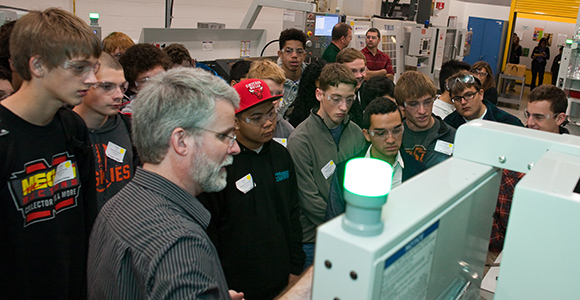
(Photo Credit: COD Newsroom/Flickr)
A long, long time ago, in a galaxy of distinguished California schools and universities, practically anyone dreaming of a job fresh out of college could find one. Fast forward to the present and Salomon Davila, Pasadena City College’s Economic and Workforce Development Dean, will explain why that dream is a thing of the past.
“The truth of the matter is we’ve been quite successful at selling the dream of ‘Go to college, get a degree and there’s a job waiting for you,’” said Davila. “That worked really well for the high economic growth we sustained over the last century or so. It was a successful blueprint. But now, as our global economy has taken hold, certain jobs that paid well 30 years ago are no longer well paid. They’re off-shored.”
What’s worse is the fact that, while California’s massive job skills gap is increasing the number of unfilled positions by the thousands, many businesses that need workers today can’t afford to wait four years for someone to graduate from college with qualified skills and training.
“The only way the employers are going to get that type of training,” said Davila, “is if they engage in the educational process and provide either an apprenticeship model or a combination of education and apprenticeship which, I think, is the mantra they’re going for in this country.”
Counselor Lynell Wiggins is also at Pasadena City College, but it’s his role as a member of the California Community Colleges’ Workforce Task Force that has him re-visiting a long-held belief: Counselors and educators can successfully put more students on the path into California’s workforce–if they stop regarding academic and career technical education (CTE) programs as two separate paths to a degree or a job, and start embracing programs that combine academics with work-based experiences.
“To enhance the workforce agenda, we need to inform, train and equip [students] at various junctures. We need to be more prescriptive. Maybe that’s what this entire Workforce Task Force is really about,” said Wiggins, suggesting that it just might yield a possible “development of a new educational master plan for our state that connects with the workforce.”
And, since the Task Force was created by the California Community Colleges Board of Governors to brainstorm recommendations for reform, Wiggins’ insights could mark the path to discussing ways to make that happen.
“Whether you go to a university or community college or have just graduated from high school,” Wiggins says, “our goal should be to produce an informed worker who can map their own progression.”
Davila revealed that’s precisely what he experienced as a student.
“I’m from Texas, originally. I participated in a career pathway program myself so I know it works,” said Davila. “I was able to work with industry people while in high school. Both the CTE and the well-integrated academics prepared me to be a well-suited, under-represented minority in an illustrious, engineering school. But here in California we’ve artificially created a bifurcated, CTE academic route. We need highly trained technical people who are academically prepared. Why separate them?”
“We’re decades behind this career pathways construct,” Davila continued, pointing out that California is also lagging in how if funds programs.
Rather than funding all programs on a flat, per-seat basis, many other states employ differential funding, meaning the state provides different levels of funding based on criteria like cost and industry demand for types of workers. That means students have a better shot at landing a job right out of college and extra funding for courses that fill an actual need.
“Imagine a community college getting paid more for those courses than, for example, a cosmetology program that we might not need as much,” said Davila. “Right now we get paid exactly the same to train the same individual and there’s no incentive for the college to really help out a program for which we have a higher need. Other states have had this differential funding already.”
And while the main job of counselors is to do exactly that–counsel students–they’re also expected to have a myriad of facts at their fingertips relating to possible careers, along with the requisite courses for pursuing them. As if those weren’t enough responsibilities, Wiggins said employers need a little counseling themselves, especially when they visit schools in search of potential workers.
“Many employers don’t have a sense of what their mission is on a community college campus,” said Wiggins. “When we try to provide that for them, it seems overwhelming to them.”
His suggestion? “At the minimum… at least tell us what your core training needs are and how you expect students to be prepared for your environment.”
Both Davila and Wiggins expressed unbridled optimism when it comes to improving pathways that give students what they want (jobs!) and employers what they need (skilled workers!).
“I’m extremely optimistic,” Wiggins said, “because I see it happening already. Through a variety of grant-funded opportunities there are pockets of development and we’re starting to really build synergy right now.”
And while that once-reliable assumption of landing a job right out of college is no longer a guarantee, Davila believes boosting California’s workforce by improving the ties between counselors, students and employers is not an impossible dream. It’s simply a matter of embracing realistic steps that have been tried and proven elsewhere.
“We have to do a better job of outreach to industry—partnership versus a factory, which is the model we currently have,” said Davila. “We produce degrees and hope that they get a job, and as I’ve mentioned to many individuals, hope is not a plan.”

